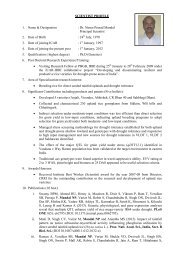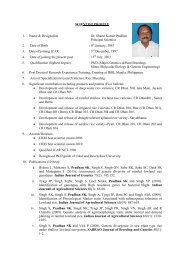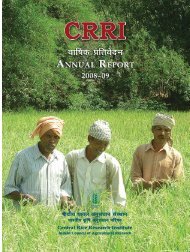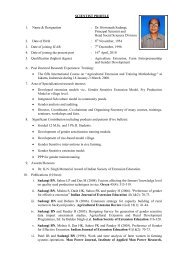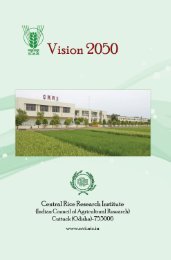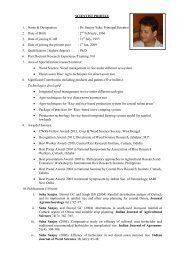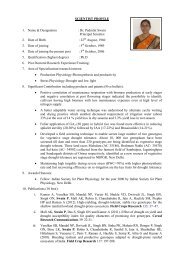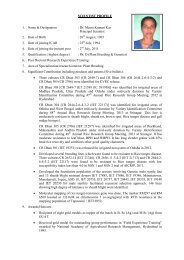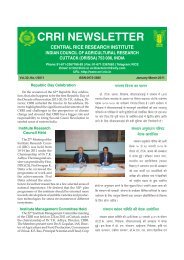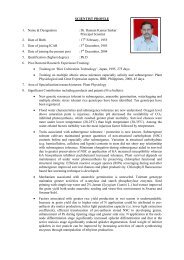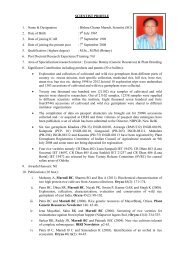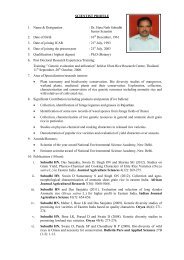Central Rice Research Institute Annual report...2011-12
Central Rice Research Institute Annual report...2011-12
Central Rice Research Institute Annual report...2011-12
You also want an ePaper? Increase the reach of your titles
YUMPU automatically turns print PDFs into web optimized ePapers that Google loves.
line sesquioxide bound zinc were higher under aerobic<br />
moisture regimes while the submergence helped to increase<br />
the manganese oxide bound zinc, amorphous<br />
sesquioxide bound zinc and residual zinc. The field<br />
study with same treatments revealed that 7% reduction<br />
in yield was observed under aerobic than the submergence<br />
condition under no Zn applied conditions. However,<br />
under Zn fertilized condition no significant yield<br />
difference was observed. Averaged over the sources of<br />
Zn application, the yield penalty of 8% was observed<br />
under aerobic condition compared to flooded condition.<br />
Microbial Resource Management and<br />
Diversity Analysis<br />
Microbial diversity of tropical soils<br />
Characterization of PGPR microbes<br />
The potent ACCdeaminase producing bacteria<br />
viz.,Bacillus (n=2), Microbacterium, Arthrobacter, Microbacterium<br />
and Paenibacillus spp. induced drought tolerance<br />
in rice and increased seed germination by about<br />
10% under anaerobic condition. Cellular protein and<br />
RAPD analysis profiles of 20 Bacillus (B) and 23<br />
Pseudomonas (Ps) strains produced 22-41 and 30-61 protein<br />
fractions, and 2-4 and 2-6 amplicons, respectively<br />
which ascertained molecular diversity of the PGPR<br />
microbes (n=680). Further more, the Bacillus spp. were<br />
more effective than the Pseudomonas spp. Among the<br />
PGPRs, 40 were osmotolerant (7-18% NaCl), 110 were<br />
HCN producer and 87 had biocontrol properties. Only<br />
2 Bt isolates fixed nitrogen and 3 produced IAA,<br />
whereas, 14 potent Bt strains solubilized P and cellulose,<br />
and produced NH 3<br />
.<br />
Microbial activity under different rice based<br />
cropping system<br />
In soil, microbial diversity in terms of fluorescein<br />
diacetate hydrolase (FDH), dehydrogenase (DH), β-glucosidase<br />
(GS), and urease, alkaline (ALP) and acid phosphatases<br />
(ACP) activities was more in rice-sesamumrice<br />
rotation compared to rice-groundnut-rice, green<br />
gram-rice-maize and cowpea-rice-maize cropping systems.<br />
However, DH (<strong>12</strong>5.06 g g -1 h -1 ), GS (102.<strong>12</strong> g g -1<br />
h -1 ) and FDH (8.41 g g -1 h -1 ) activities were maximum<br />
in rice-groundnut and minimum in rice-cowpea crop;<br />
Urease (71.<strong>12</strong> mg g -1 h -1 ), ACP (67.53 g g -1 h -1 ) and ALP<br />
(98.22 g g -1 h -1 ) were maximum in rice-sesamum and<br />
minimum in rice-greengram cropping systems.<br />
In another study, effect of different treatments viz.<br />
FYM (5 t ha -1 ) with Sesbania aculeata, urea (60 kg N ha -1 ),<br />
rice straw (5 t ha -1 ) with urea (60 kg N ha -1 ) (RSU), FYM<br />
(5 t ha -1 ) with Sesbania aculeata (FYMS), FYM with Azolla<br />
(5 t ha -1 ) (FYMA), rice straw with Sesbania aculeata (RSS)<br />
on soil enzymatic activities was evaluated. The treatment<br />
RSU resulted higher DH (135.86 g g -1 h -1 at panicle<br />
initiation (PI) stage), GS (135.86 g g -1 h -1 at PI) and urease<br />
(84.01 mg g -1 h -1 at maximum tillering (MT) stage)<br />
activities followed by FYM Sand only urea; while FDH<br />
(11.70 g g -1 h -1 at MT), ALP (108.72 g g -1 h -1 at PI) and<br />
ACP (87.35 g g -1 h -1 at PI) were more in FYMS treatment.<br />
Characterization of pesticide degrading bacteria<br />
Nine chlorpyrifos degrading bacteria were identified<br />
as Achromobacter xylosoxidans sub sp. xylosoxidans,<br />
Xanthobacter flavus, Stenotrophomonas maltophilia,<br />
Inquilinus limosus, Bacillus sp. and Sphingobium fuliginis.<br />
After Phenotyping and phylotyping Methylobacterium<br />
sp was identified as α, β, γ and δ-HCH degrader, which<br />
degraded β-HCH from onset of growth and optimum at<br />
stationary phase. β-HCH degradation was a novel<br />
record.<br />
Diversity analysis of entomopathogenic microorganisms<br />
in rice ecosystem<br />
Seventeen B. thuringiensis and 59 Pseudomonas<br />
strains isolated from different rice ecology produced<br />
siderophore, HCN and salicylic acid, effective against<br />
insect pests and plant pathogens. The Bt (n=<strong>12</strong>) isolates<br />
tolerated 8-18% osmotic stress. The osmolytes like<br />
amino acids rendered tolerance to 3 and proline to 11<br />
isolates but the osmozymes SOD and catalase rendered<br />
stress tolerance to all Bt isolates. The ectC and ectABC<br />
osmotolerant genes were identified in the isolates.<br />
Out of 49 Bt strains isolated, 4 strains had the LC 50<br />
values as 3.16x10 6 - 1.25x10 9 spore-crystals ml -1 against<br />
LF in the field grown with rice cv. Sarala, Lalat, Naveen<br />
and Swarna. The commercial strains i.e. TB70 of<br />
bactospeine and TB73 of biolep were less effective than<br />
the indigenous strains. Four potent native<br />
entomopathogenic Bt against LF were formulated for<br />
mass field application.<br />
Five cry genesamplified by CJI1/CJI2, CJ4/CJ5, V(-)/<br />
V(+), gral-nem(d)/gral-nem(r), gral-cyt(d)/gral-cyt(r)<br />
amplimers, effective against the lepidopteran and coleopteran<br />
pests of rice were identified from 67 out of<br />
321 Bt isolates.<br />
Improving Nutrient Use Efficiency of<br />
Upland <strong>Rice</strong> through Native Beneficial<br />
Soil Microorganisms<br />
Integration of Arbuscular Mycorrhiza (AM)-<br />
based bio-fertilizer with rice based cropping<br />
systems<br />
The AM-supportive crop management components<br />
viz., (i) crop rotations (ii) application of AM inoculum<br />
64 CRRI ANNUAL REPORT 2011-<strong>12</strong>



